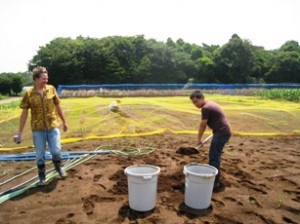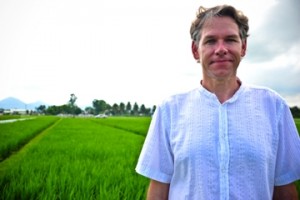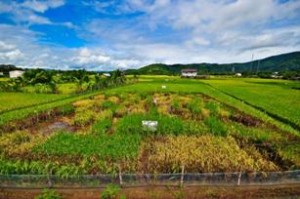“It is very rare that scientists can take their projects wherever they go. I’ve been very lucky to be able to do this, and much of this has to do with the support I’ve received from GCP.” – Matthias Wissuwa
In the world of phosphorus, Matthias (pictured) is somewhat of a ‘rock star, not that he would admit to it. We don’t understand why not, since to borrow his words, the project he’s involved has becoming something of a ‘celebrity project’ in the scientific community.
For a decade-and-a-half, he has searched tirelessly for a rice gene that could improve the crop’s yield in phosphorus-deficient soils –which make up half of the world’s soils. Last month, his transnational team published in Nature that their 15-year quest had ended, having finally found the elusive gene – Pup1.
We celebrate this happy ending, especially as we had the added pleasure of talking to Matthias recently: it was delightful in listening to the modest German recount the long journey which has taken him from his home town of Hamburg, to USA, Japan, The Philippines and back to Japan, all this while, faithfully ‘carrying’ Pup1 with him as he switched employers. As you’ve seen, Japan scores a double strike, so our ‘rock star’ is also ‘big on Japan’!
Talking to Matthias, we could sense the achievement was only just sinking in – that he and his team’s years of laboratory work was becoming a practical reality that will aid rice-growing farmers from Africa to Asia, and hopefully other grain growers in years to come. Here’s what Matthias had to say…
You started this project back in 1997. Tell us how you became interested in phosphorus deficiency and rice.
After completing my PhD in the United States, I accepted a postdoc position in Tsukuba, Japan, with the National Institute of Agro-Environmental Sciences (NIAES). It was an easy decision because my wife is Japanese.
My postdoc host, Dr Ae was interested in phosphorus, particularly in legumes. I originally started work on tolerance to phosphorus deficiency in groundnuts, but soon changed to rice to take advantage of the molecular tools available for rice.
Tsukuba is a very new city. It’s called The Science City in Japan because the Japanese government built it to house all the national research institutes. This was great for me as I became interested in QTL mapping, which was pioneered by scientists in Tsukuba. I got talking to people in the rice research community in Tsukuba and was introduced to Dr Yano, who was developing mapping populations for rice at the National Institute of Agrobiological Sciences. He kindly gave me his populations and that’s how I started to map QTL for phosphorus-deficiency tolerance in rice.
Dr Ae was perplexed by my decision, believing that studying legumes was far more challenging than rice. He always told me: “Rice is boring. They just make long, fine roots to capture phosphorus.” That was 15 years ago and he turned out to be right. Long roots are the secret for phosphorus uptake in rice, particular in Kasalath and varieties like that.
Did you share Dr Ae’s hypothesis that longer roots were the secret to some rice varieties being able to tolerate phosphorus-deficient soils?
For a long time, I was not sure if it was just long roots. It was a real chicken-and-egg scenario – does strong phosphorus uptake spur root growth, or the other way around?
As it turns out, it is the latter – plants growing longer roots help with the uptake of more phosphorus – and Pup1 is responsible for this.
We have now shifted our aim and are looking for varieties of rice tolerant to phosphorus-deficient soils that either:
- release organic acids, phosphatases or some other compound that makes phosphorus more readily available for the plant to absorb, or
- manipulate soil microorganisms to favour those that can aid in making phosphorus more soluble, or
- very efficiently utilise phosphorus once it is taken up.
All three mechanisms are found in legumes, so there is reason to believe that they exist in rice and we are now working on finding them.
GCP has been interested in the project since 2004 as its outcome aligns with GCP’s goals to improve crop yields and security in developing countries… It has become something of a ‘celebrity project’ in the scientific community, attracting researchers to work on the project or collaborate with us.
In 2002 you left NIAES and accepted a position with the International Rice Research Institute (IRRI), and were encouraged to continue your work on Pup1. When you moved back to Tsukuba in 2005 to accept the position you currently hold with the Japan International Research Center for Agricultural Sciences (JIRCAS), you were again encouraged to continue your Pup1 project, collaborating with your successor at IRRI, Dr Sigrid Heuer. How important has it been to you and the project to have the support of your institutes?
It is very rare that scientists can take their projects wherever they go. I’ve been very lucky to be able to do this, and much of this has to do with the support I’ve received from GCP. They’ve been interested in the project since 2004 as its outcome aligns with GCP’s goals to improve crop yields and security in developing countries.
When I left IRRI, Sigrid was just starting and was more or less free to take on the project, so I asked her if she’d be interested in continuing my work with Pup1 at IRRI and collaborate with me in Japan. She was actually the perfect person for the project because her background in molecular biology complemented my background as a plant breeder.
Over the past seven years, we have worked together very well, and with the addition of Rico Gamuyao, a PhD student supervised by Sigrid, things have recently progressed quite quickly to the point that we were able to pinpoint Pup1.
So GCP has played a major role along your journey?
Yes, definitely. The support from GCP on the Pup1 project, now in its 8th year, was instrumental at getting this project to where it is.
Quite simply, the funding from GCP allowed us to hire Rico as well as Juan Pariasca-Tanaka, a project scientist with me at JIRCAS. Neither Sigrid nor myself had the time to do all the hands-on work so having both Rico and Juan has been hugely helpful.
How important has the collaboration between IRRI and JIRCAS been for the project?

Are they playing with mud? Not at all! Working. Matthias (L) and Rico (R) have zipped up their boots and gone back to their bee…er…. we mean, roots, mucking mud here as they do some fieldwork related to the search for PSTOL1.
Tremendously important. Sigrid’s group at IRRI is relatively small as is mine in Japan, so we rely on each other’s complementary expertise when working on complicated projects.
We have also been fortunate to have constant interest in the project from the scientific community. It has become something of a ‘celebrity project’, and as such, attracted researchers to work on the project or collaborate with us.
For example, we are working with two US groups at Cornell University and Penn State, that are also funded by GCP, trying to track down Pup1 in other crops and identifying genes that control root architecture, and how different architectures may affect P uptake.
These collaborations are really exciting, and make it possible to answer questions that we could not answer ourselves, or that we would have overlooked, were it not for the partnerships.
It really has been a team effort and we wouldn’t have got to where we are now without all the help of everyone involved
You’ve been described as the Godfather and Guru of Pup1. How do compliments like this make you feel?
It makes me laugh but of course it’s a very well-meant comment, and to some extent, considering I’ve worked on it for 15 years, you could say that there is some truth to it.
I’ve done all the original work, but Sigrid has been just as instrumental. She did the part where my expertise was no longer adequate – the molecular side, looking at genes and thinking about the function of a gene and testing for its function.
It really has been a team effort and we wouldn’t have got to where we are now without all the help of everyone involved, which also includes the support of Dr Yano over the years.
…phosphorus deficiency is a worldwide problem that has recently gained public attention because of how expensive phosphate fertilisers have become…Farmers are always interested in saving money and improving yields and we believe this discovery will help with both.
Have you been surprised by the attention this project has received?
As I said, the project has always been in the scientific spotlight because it was the first to map a major QTL for phosphorus uptake.
We knew from the Sub1 story – the submergence tolerance gene, which was published in Nature 4–5 years ago – that the media would probably be interested in this similar discovery. I’m still very surprised that this unsexy story has caused such interest.
You have to remember though, phosphorus deficiency is a worldwide problem that has recently gained public attention because of how expensive phosphate fertilisers have become. About four years ago, the price almost tripled and continues to stay high.
Farmers are always interested in saving money and improving yields and we believe this discovery will help with both.
Phosphorus deficiency is probably even more critical in Africa than it is in Asia… This means Pup1 may have its biggest impact in Africa.
How will the research continue?
Having focused so much on the basic research, we now want to turn our attention to the application. IRRI and JIRCAS will train national breeding programmes to use marker-assisted selection and help them breed their own rice varieties with Pup1.
Sigrid and IRRI are mainly working with Asian national breeding programmes and we at JIRCAS focus more on African programmes such as the Africa Rice Center. Phosphorus deficiency is probably even more critical in Africa than it is in Asia, as phosphate fertilisers aren’t used nearly as much as they are in Asia. This means Pup1 may have its biggest impact in Africa.
We are also looking for new sources of tolerance to phosphorus-deficiency. One very exciting project involves West African rice (Oryza glaberrima) the father of the Nerica ™ (New Rice for Africa) varieties.
So far, we have found that this rice is very tolerant to phosphorus-deficient soils. It does have Pup1, but in addition harbours novel genes that also enhance performance on phosphorus-deficient soils.
We hope to discover a Pup2 in the years to come.
Links
- PODCASTS: Catch Mathias’ interview on Episode 3.1 and Episode 3.2
- Press release: Rooting and shooting for rice
- Media coverage
- Matthias’ home page
- Improving rice in Asia
- Comparative Genomics Research Initiative
- Meet the PSTOL1 research team on Flickr or Facebook
- Sub1: See post on submergence and salinity tolerance from a PhD student working on these two traits for rice
- Facts and figures on rice (IBP website)
- Join the rice research community online (IBP website)









